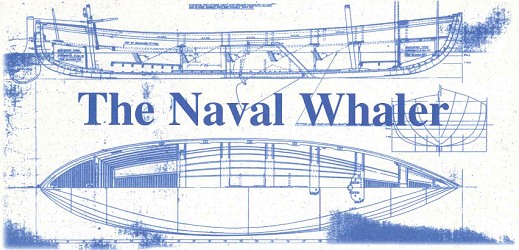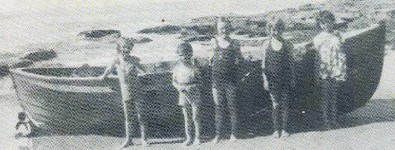| home | catalogue | history | references | appendix |
 surfresearch.com.au jervis bay whaleboat crew, 2015 |
 |
The Jervis Bay Whaleboat Crew:
The JBMM Small Wooden Boat Fleet and the Whaleboat Project, 2015-2019
Introduction
The Jervis bay Whaleboat Crew (JBWC) is a group of enthusiastic and committed volunteers dedicated to the study, documentation and use in a contemporary environment of wooden rowing and sailing boats.at the Jervis Bay Maritime Museum, Huskisson, NSW.
The JBMM's Small Wooden Boat Fleet (JB-SWBF) presently comprises six vessels.
There are two sailing boats, the Pedro and a RAN Montagu Whaler, a work-boat that was also pulled by a crew of five.
Both of these are clinker built, as is the Warren and the Era Beach Surf-boat, both craft were originally were propelled by oars but later fitted with an motor.
The recreational craft, the canoe and surf-ski, are constructed in marine plywood.
The museum also holds the Sea-Bee runabout.
Built in aluminium and fitted with an outboard motor, by definition, it is not a member of the JB-SWBF.
Following the formalisation of the JBMM Strategic Plan 2015-2020 and the upcoming Wooden and Model Boat Festival in October, a group of members and volunteers expressed a particular interest in and an appreciation of the value of the heritage small wooden boat fleet.
These vessels comprise a diverse range of designs and they are mostly paddled, rowed or sailed, or powered by brawn or breeze.
The Montagu Whaler (1890-1965), or the whaleboat, is the outstanding vessel in the museum's collection of small wooden boats .
In recognition of this, the volunteers are known as the Jervis Bay Whaleboat Crew (JBWC) and the long-term objectives are to maintain, oversee further restoration, enhance the presentation, and research and document the history of the heritage small wooden boat fleet.
A brief outline of priorities and objectives for the first phase, to the end of 2015, was prepared.
Phase 1: 2015.
A. The Monatgu Whaler
1. Prepare and submit a provisional application to assess the potential of including the whaleboat on the Australian Heritage Vessels Register.
2. Establish formal contact with RAN Air-Arm Museum HMAS Albatross and the RAN Maritime Museum, Garden Island, to facilitate research and for professional advice and expertise.
3. Detail the whaleboat's current condition and note any concerns.
4. Following professional consultation and advice, clean the whaleboat and the superstructure.
5. Thereafter, establish a regular cleaning and maintenance schedule.
6. Search the museum precincts to collect and collate any and all of the sails, rigging, gear and other material that are associated with the whaleboat or the heritage small wooden boat fleet..
7. Ensure that the details of the whaleboat and the respective gear are fully and correctly entered into the museum's digital catalogue.
8. Scan, digitalise and update the whaleboat file held by CMC.
9. Seek professional information and advice on the restoration and conservation of the whaleboat's sails and rigging.
10. Initiate research into the numerous and varied whaleboat histories that pertain to the the JBMM's Montagu Whaler.
B. Small Wooden Boat Fleet
1. Consult with the JBMM Curator to ensure the highest conservation practices are maintained.
2. Prepare a brief condition report on the vessels of the JBMM heritage small wooden boat fleet.
3. Confer and consult with the JBMM Exhibition staff to enhance the presentation and appreciation of the fleet for museum visitors.
4. In particular, rebuild or modify the dollys of the sail boat Pedro and the dingy, Warren.
5. Establish formal contact with the the Australian Heritage Fleet, the ANMM and the Vaughan Evans Library to facilitate research and for professional advice and expertise.
6. Work in association with museum volunteers and members in the exhibition and promotion of the JBMM heritage fleet.
7. Actively recruit enthusiastic and committed volunteers with a range of skills and experience to the JBWC to contribute to the success of the project.
8. Explore the potential avenues to study the use of heritage small wooden boats in a contemporary environment.
9. Prepare an outline of priorities and objectives of the JBWC for Phases 2-5, 2016-2020.
2015_09_01_JBWC_Project_1
A. The Monatgu Whaler
1. Prepare and submit a provisional application to assess the potential of including the whaleboat on the Australian Heritage Vessels Register.
The provisional application was forwarded to the Australian Heritage Vessels Register in September 2015, and Mr. David Payne has acknowledged the application and indicated that the application was scheduled for assessment in 2016.
He revisited and examined the JBMM whaler in October and made several constructive comments and suggestions.
2. Establish formal contact with RAN Air-Arm Museum HMAS Albatross and the RAN Maritime Museum, Garden Island, to facilitate research and for professional advice and expertise.
Other possible interviewees are
Mr. Max Forster of Old Erowal Bay and Mrs. Alice Westmore,
widow of Rohan Westmore; two contacts kindly provided by Mr.
John Hatton.
Further avenues of research are a number of persons associated with the restoration project identified by Rohan Westmore in 1994,
including a list of the participating pupils at Vincentia Public School.
The assistance and contributions by Rebekah Clements, Collections Assistant at the New Zealand Maritime Museum, and Andrea Hemmins, Photographic Archivist at the National Museum of the Royal New Zealand Navy, have been particularly valuable.
3. Detail the whaleboat's current condition and note any concerns.
The present condition of the JBMM’s Montagu Whaler could be said to be fair.
The Hull
The hull appears largely structurally sound, with the exception of three areas of concern.
There is a small crack in the hull, forward on the port side, and visible signs of stress under the stem and stern.
The latter was identified in October by David Payne and; on his suggestion; two blocks have been wedged into position to provide temporary support.
Paint Work
The paint work is on the exterior of the hull is in fair condition, but the interior is considerably better..
However, on most of the removable timber sections (that is, the grates, fore sheets, bottom boards, etc.) the varnish has cracked and visibly deteriorated.
These are need to be refurbished, a relatively simple process that would see the removal of the components to a suitable location for sanding and re-varnishing, projected for 2016-2017.
Similarly, the brass work requires cleaning with a suitable compound, particularly the dedication plate.
A Semi-enclosed Location
The condition of the vessel is not unexpected, given the vessel’s semi-enclosed location.
Although largely a dry area, the exhibit is subject to damage from the sun, wind, and extremes of temperature.
Critically, the question of security is of considerable concern, highlighted by the recent (noted 6th November) damage and theft when a brass cleat was removed from the rear thwart on the starboard side.
The replacement of the cleat could be difficult, if not expensive.
Vandalism
and Fire
Of more concern is the possibility of damage by fire, either by natural causes or in a case of vandalism.
It is known that a Montague Whaler was destroyed at the LDMM by bushfire in 2001; to lose one whaleboat to fire may be regarded as a misfortune, to lose two looks like carelessness.
At the latest insurance assessment, the Montage Whaler was professionally valued at $? (dollar value available at the discretion of the Curator).
However, whatever this figure actually is, and admittedly without an intimate knowledge of the provisions of the current JBMM insurance policy, it is possible that the whaler’s present unsecured location may present some difficulties in any claim for damage or destruction.
Repainting the Hull
Following, or during, the proposed removal and restoration of the internal timber sections (projected for 2016-2017 and detailed above), attenttion focuses on the restoring the paint on the hull.
Without question, such major work needs to be examined fully before committing to its implementation.
At an extreme, depending on the extent of work required and a consideration of current WHS provisions in relation to facilitating access for the volunteers, there is a possibility that the vessel may have to be relocated, perhaps several times.
The Original Colours
The selection of the colour scheme is not in question.
On collection by the LDMM in 1991, both whalers had white hulls, were dark red below the water-line and with blue gunwales.
These colours were replicated by Alf Settree and the students of Vincentia Public School in their restoration of the whaler and in evidence when the boat was installed at the Museum in 1993.
Inexplicably, at some unknown point the whaler was
re-painted in battleship-grey by persons and for reasons
unknown.
There is no documentation in the JBMM’s files as to this unfortunate development, erasing of the work and intentions of the original restoration.
Furthermore, apart from the inappropriate choice of battleship-grey, the original and correct palette of blue-white-red is undoubtedly far more attractive and eye-catching.
Also note that the original restoration included looped life-lines along the gunwales, which are no longer present.
A detailed appraisal of the proposed re-painting of the whaler’s hull in the original colours, is to be prepared and documented in the JBWC Project for 2016-2017.
Lastly, the condition of the fittings supporting the ropes around the exhibit area are in poor condition.
Examination of possible alternatives will be canvassed by the JBWC in the new year and suggestions or solutions included in the JBWC Project for 2016-2017.
4. Following professional consultation and advice, clean the whaleboat and the superstructure.
After a consultation canvassing the general principles for cleaning a clinker boat with Shane Nunn, Shipwright, Sydney Heritage Fleet, at Pyrmont in September, the JBWC carried out the following work.
The mast was removed from the whaler and stored in the Ferry Well.
The whaleboat was cleaned inside and out in preparation for the Wooden Boat and Model Ship Festival in October.
The vessel was swept with a soft hand brush and then, using two buckets, each section was washed with a soft cleaning cloth using water with light detergent and then rinsed with water.
5.
Thereafter, establish a
regular cleaning and maintenance schedule.
This objective scheduled for introduction in early 2016.
6. Search the museum precincts to collect and collate any and all of the sails, rigging, gear and other materials associated with the whaleboat or the heritage small wooden boat fleet.
There are two pairs of oars,
one pair in raw condition, and one blade
has badly splintered.
The second pair is in used condition, showing extensive wear, particularly to the blades which have been repaired with metal strips and nails.
7. Ensure that the details of the whaleboat and the respective gear are fully and correctly entered into the museum's digital catalogue.
This objective is currently on hold, awaiting further technical advice.
8. Scan, digitalise and update the whaleboat file held by CMC.
Scanning and digitalisation of the CMC Whaleboat files was completed in October 2015.
These are now available to the Curator on request.
9. Seek professional information and advice on the restoration and conservation of the whaleboat's sails and gear.
There is one set of sails comprising a main and a mizzen sail, but no jib.
There are two sets of masts, spars and rigging, with the sails fixed by ropes to one set of spars.
The Sails
The main sail is in very poor condition and the mizzen sail is not much better, although most of the ropes appear in good condition and closely conform to their positions as depicted in the literature.
Initial research has indicated that the subject of the restoration and conservation of sails is complex, confusing, and possibly very expensive.
Future avenues for further comments and advice include the ANMM and the SHF, and possibly staff at the Powerhouse Museum and the Australian Museum.
At this point, it is clear that the main and mizzen sail, and their spars and rigging should be continued to be kept in store, awaiting a more detailed and definitive analysis.
Masts, Spars and Rigging
All the masts, spars and rigging all appear to be in reasonable condition, apart from the second mizzen spar which has a broken end, missing about 45cm.
All the metal parts appear to be in evidence, but show signs of considerable wear.
However, in all cases, the varnish on the timber beams is cracking, worn and generally deteriorating.
The JBWC proposes that the second rig, be restored by a group of volunteers to working condition, a detailed appraisal to be provided in the JBWC Project for 2016.
Furthermore, it is proposed that that in conjunction with restoring the second rig, the possibility of establishing a group of volunteers to replicate a jib and the main and mizzen sails should be explored.
On the completion of these projects, the replica sails fitted on the restored masts and spars would produce a full working rig, that would be practical and a valuable addition in exhibiting this vessel.
The Oars
A similar approach is envisioned for the oars.
It is proposed that one pair be retained in their current condition and the second pair, ideally those in raw condition, should be restored to working condition to compliment the level of restoration of the whaler.
This would be carried out in conjunction with the proposed restoration of one set of masts and spars by the volunteer crew.
As a long-term objective (following the accumulation of practical skills and experience by the crew members following the restoration process of the whaler’s masts, spars and oars), the construction of a third pair of replica oars becomes a possibility.
Ideally, these should be another 15ft oar and the second, a 16ft sweep oar.
As above, a detailed appraisal of this proposal is to be provided in the JBWC Project for 2016.
10. Initiate research into the numerous and varied whaleboat histories that pertain to the JBMM's Montagu Whaler.
Constructed by Navy Shipwrights (872) or by Contractors (1107) ? ... and a mysterious Third Whaler.
The history of the JBMM's Montagu Whaler is a work in progress, complicated by its construction from two boats, numbers 872 and 1107. Further confusion arises with the provenance of a third whaler, said by Rohan Westmore to be supplied by Albatross Aviation Museum and stripped of its brass fittings to complete the restoration.
In addition, there is the question of the identity of a whaler known to be destroyed at the LDMM by a bushfire in 2001.
Apart from the brief report by Rohan Westmore, unfortunately, the identity of these ghost ships is not otherwise recorded in the JBMM files.
This report also suggests that
1107 was made by
outside contract, as it
does not follow the Garden Island type of construction.
However, it appears that, by implication, 872 was built by navy shipwrights about 1944, Nirimba’s Shipwright confidently stating that it is 42 years old (in 1988).
In 1994, Rohan Westmore suggested a similar date of construction, reporting that the boat was built in Fremantle in 1945.
Given the the ship’s emblem afixed at the stem, it s probable that at least one of the whalers served aboard HMAS Queenborough, but this requires further research.
An International, and a Multi-functional, Vessel
Importantly, the history of the vessel’s design and its extensive use by the navies of Empire-Commonwealth nations is rich and fascinating, and with the staff at two museums in New Zealand already making a significant contribution.
While its reputation as a pulling and sailing work-boat is ensured, the Montagu Whaler also played an important role as a training vessel and it was sailed competitively and for pleasure.
Relevant documents, images and commentary are being complied digitally, some of these files are available to the Curator on request, and some others are now available online.
2015_12_25_JBWC_Project_1_ Report_A
B. Small Wooden Boat Fleet
1. Consult with the JBMM Curator to ensure the highest conservation practices are maintained.
The Curator is in regularly updated on all the work of the JBWC, as is the Exhibitions Coordinator and recently appointed manager, Ms. Diana Lorenz.
2. Prepare a brief condition report on the vessels of the JBMM heritage small wooden boat fleet.
Pedro
Warren
Plywood
Canoe
Almost generic in design and construction, the plywood canoe was used extensively around the world as a pleasure craft up to the 1970s, before being replaced by fibreglass and plastics.
This example of a plywood canoe is in good condition, as is its two-bladed paddle.
However the brass (?) screws that fix the plywood hull panels are prone to deterioration, producing a green powdery deposit at the screw-head.
Although these deposits were easily removed when the canoe was cleaned and prepared for the Wooden Boat and Model Ship Fair in October, they will certainly reappear over time.
The is some variation discernible in the quality of the finish of the varnish, initial feedback suggesting that it was possibly (inexpertly) re-vanished prior to its donation.
Thus, the screw-heads have not been properly sealed and they are susceptible to oxidisation.
The stand for the canoe was refurbished in September by the JBWC, with the addition of wheels to construct a dolly.
This dolly is yet to be painted, in black, to conform with the dollies of the other boats in the SWBF.
Surf-Ski
The surf-ski was invented by Port Macquarie fisherman, Harry McLaren in the 1920s and the design now commonly used at beaches around the world.
This huge double ski was built in Sydney, but used locally for fishing trips to Bowen Island.
The hull is in reasonable condition, but the varnish on the deck has badly deteriorated and it easily accumulates dust.
There are four leather foot-straps, a metal bung, and a metal fitting at the stern, probably to house a (missing) small rudder, worked by cables by the rear crewman.
Unfortunately, there are no paddles; these are usually with off-set double blades.
In its current location in the Ferry Well, the condition of the varnish can only further degrade.
As these craft were regularly reconditioned at the beginning of each summer, a sympathetic light sanding and re-varnishing of the JBMM surf-ski is definitely over-due.
This would also substantially improve the presentation of the vessel as a quality exhibition piece.
Furthermore, given its extreme length but very light weight, consideration could then be given to displaying the refurbished ski, at a suitable location in the museum, suspended by cables.
Lady Denman is inappropriate.
Firstly, its location on the ferry effectively sublimates the boat's significant status.
Secondary, its apparent role as the Lady Denman's tender is questionable.
Over many years of service, the ship's boat was probably a number of different craft, with an aluminium dingy in use by 1962.
While the surf-boat could be said to approximate the tender of circa 1956, all the known tenders had a transom, that is a square stern.
Also, given they were required for emergency use, the tenders were never fitted with a cover.
Characteristic
of its period, the Era Beach
surf-boat has a pointed stern,
similar to the classic whale-boat.
Sea-Bee
Runabout
This boat is on the Australian Historic Vessels Register.
By definition, the aluminium Sea-Bee is strictly not part of the JBMM's Small Wooden Boat Fleet.
However, some observations can be made.
Futhermore, locating and mounting a suitable
outboard motor would vastly enhance the
presentation of the boat, CMC records
indicating that the particular models
were a 14.5 HP McCulloch in the 1960s, and a 20 HP Johnson in the 1970s.
3. Confer and consult with the JBMM Exhibition staff to enhance the presentation and appreciation of the fleet for museum visitors.
In conjunction with Diana Lorenz, the JBWC prepared the Montagu Whaler to facilitate inspection and and similarly relocated the vessels of the SWBF for the Wooden Boat and Model Ship Fair in October.
The JBWC also assisted in the presentation of museum's collection of model ships, including the recently refurbished diorama of the Lady Denman under construction.
Apart from the Montague Whaler, all the SWBF vessels were on exhibition during November-December 2015 in the Vera Hatton Gallery.
4. In particular, rebuild or modify the dollies of the sail boat Pedro and the dingy, Warren.
The Pedro dolly was constructed by the JBWC during August and the dolly for the Warren completed in September, however it is still to be painted.
In addition, a dolly was constructed for the plywood canoe.
5. Establish formal contact with the the Australian Heritage Fleet, the ANMM and the Vaughan Evans Library to facilitate research and for professional advice and expertise.
The JBWC met with Shane Nunn, Sydney Heritage Fleet Shipwright, at Pyrmont in September for an informal but wide ranging discussion about messing around with boats.
David Payne of the ANMM and the AHVR has already offered significant support and information in respect of the SWBF.
Fortunately the catalogue of the Vaughan Evans Library is online via Trove, and inter-library loans are expertly arranged by Marie Torbruegge at the Shoalhaven City Library, Berry Street, Nowra.
In addition, following the visit of David Payne to the JBMM in October, contact has been made with Jenny Chapman and Chris Curry at the Berry Museum.
Included in their substantial collection is a flood-boat, one of two built by David Berry in 1860.
The second is held by the Shoalhaven City Council at their Ulladulla Depot and it is said to be installed in the new Swimming Centre being nearing completion at Nowra.
David is preparing documentation to have both vessels entered on the AHVR in 2016.
Remarkably, the Berry boat still has its horse-drawn cart, with solid block timber wheels.
VaughanEvans Library
H. T. Lenton and J. J. Colledge: Warships of World War II
London : Ian Allan, 1962-1968.
8 volumes. (72; 81; 96; 81; 71; 81; 72; 80 p.) : ill. ; 19 cm.
Part 6:Trawlers, Drifters and Whalers.
623.8252 LEN (000641-643,645-9)
Pullen, Rex: Survival at sea : in the whaler after the sinking of HMAS Armidale in 1942 : a personal account.
Glenorchy, Tas. : The Author, 1998.
8 leaves ; 30 cm.
940.545994
Australian War Memorial. Research Centre.
F 940.545994 P982s
6. Work in association with museum volunteers and members in the exhibition and promotion of the JBMM heritage fleet.
Ongoing.
7. Actively recruit enthusiastic and committed volunteers with a range of skills and experience to the JBWC to contribute to the success of the project.
This objective is currently on hold, and has been re-scheduled for early 2016.
8. Explore the potential avenues to study the use of heritage small wooden boats in a contemporary environment.
This objective is currently on hold, and has been re-scheduled for early 2016.
9. Prepare an outline of priorities and objectives of the JBWC for Phases 2-5, 2016-2020.
In preparation, scheduled for publication in early 2016.
2015_12_25_JBWC_Project_1_ Report_B
A Note on Maintaining a Collection in a .
In Museum Land, the current mantra is to retain the object in the condition in which it is acquired.
While this may be feasible for professional institutions, it is a heavy burden for small regional museums.
John Settree
After building timber boats for the past 60 years, John Settree, closed the family business in May 2014.
The Settree family began building timber boats and ferries on the banks of Currambene Creek at Huskisson in 1828.
Some of the vessels were up to 180 feet long and were used on the coastal and inland trade.
When his grandfather ran the business there were up to 24 employees, with modern technology the number declined to four.
The Jervis bay Whaleboat Crew (JBWC) is a group of enthusiastic and committed volunteers dedicated to the study, documentation and use in a contemporary environment of wooden rowing and sailing boats.at the Jervis Bay Maritime Museum, Huskisson, NSW.
The JBMM's Small Wooden Boat Fleet (JB-SWBF) presently comprises six vessels.
There are two sailing boats, the Pedro and a RAN Montagu Whaler, a work-boat that was also pulled by a crew of five.
Both of these are clinker built, as is the Warren and the Era Beach Surf-boat, both craft were originally were propelled by oars but later fitted with an motor.
The recreational craft, the canoe and surf-ski, are constructed in marine plywood.
The museum also holds the Sea-Bee runabout.
Built in aluminium and fitted with an outboard motor, by definition, it is not a member of the JB-SWBF.
| JBWC Project, Sept 2015 | JBWC Report, Dec 2015: | Montagu Whaler | Era Surf-boat |
|
|
Warren | Canoe | Surf-ski |
| [Sea-Bee] | JB-SWBF | JBWC Info | Whaleboat History |
|
Vera Hatton with one of the Whalers at Balmoral, 1991. Photograph: Keith
Moore.
|
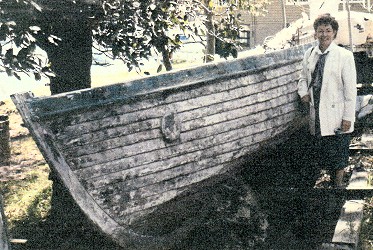 |
Phase
1, September 2015.
Following the formalisation of the JBMM Strategic Plan 2015-2020 and the upcoming Wooden and Model Boat Festival in October, a group of members and volunteers expressed a particular interest in and an appreciation of the value of the heritage small wooden boat fleet.
These vessels comprise a diverse range of designs and they are mostly paddled, rowed or sailed, or powered by brawn or breeze.
The Montagu Whaler (1890-1965), or the whaleboat, is the outstanding vessel in the museum's collection of small wooden boats .
In recognition of this, the volunteers are known as the Jervis Bay Whaleboat Crew (JBWC) and the long-term objectives are to maintain, oversee further restoration, enhance the presentation, and research and document the history of the heritage small wooden boat fleet.
A brief outline of priorities and objectives for the first phase, to the end of 2015, was prepared.
Phase 1: 2015.
A. The Monatgu Whaler
1. Prepare and submit a provisional application to assess the potential of including the whaleboat on the Australian Heritage Vessels Register.
2. Establish formal contact with RAN Air-Arm Museum HMAS Albatross and the RAN Maritime Museum, Garden Island, to facilitate research and for professional advice and expertise.
3. Detail the whaleboat's current condition and note any concerns.
4. Following professional consultation and advice, clean the whaleboat and the superstructure.
5. Thereafter, establish a regular cleaning and maintenance schedule.
6. Search the museum precincts to collect and collate any and all of the sails, rigging, gear and other material that are associated with the whaleboat or the heritage small wooden boat fleet..
7. Ensure that the details of the whaleboat and the respective gear are fully and correctly entered into the museum's digital catalogue.
8. Scan, digitalise and update the whaleboat file held by CMC.
9. Seek professional information and advice on the restoration and conservation of the whaleboat's sails and rigging.
10. Initiate research into the numerous and varied whaleboat histories that pertain to the the JBMM's Montagu Whaler.
B. Small Wooden Boat Fleet
1. Consult with the JBMM Curator to ensure the highest conservation practices are maintained.
2. Prepare a brief condition report on the vessels of the JBMM heritage small wooden boat fleet.
3. Confer and consult with the JBMM Exhibition staff to enhance the presentation and appreciation of the fleet for museum visitors.
4. In particular, rebuild or modify the dollys of the sail boat Pedro and the dingy, Warren.
5. Establish formal contact with the the Australian Heritage Fleet, the ANMM and the Vaughan Evans Library to facilitate research and for professional advice and expertise.
6. Work in association with museum volunteers and members in the exhibition and promotion of the JBMM heritage fleet.
7. Actively recruit enthusiastic and committed volunteers with a range of skills and experience to the JBWC to contribute to the success of the project.
8. Explore the potential avenues to study the use of heritage small wooden boats in a contemporary environment.
9. Prepare an outline of priorities and objectives of the JBWC for Phases 2-5, 2016-2020.
2015_09_01_JBWC_Project_1
Phase1
Report, December 2015.
A. The Monatgu Whaler
1. Prepare and submit a provisional application to assess the potential of including the whaleboat on the Australian Heritage Vessels Register.
The provisional application was forwarded to the Australian Heritage Vessels Register in September 2015, and Mr. David Payne has acknowledged the application and indicated that the application was scheduled for assessment in 2016.
He revisited and examined the JBMM whaler in October and made several constructive comments and suggestions.
2. Establish formal contact with RAN Air-Arm Museum HMAS Albatross and the RAN Maritime Museum, Garden Island, to facilitate research and for professional advice and expertise.
| Ailsa Chittick at the RAN Air-Arm Museum and
John Smith at the RAN Maritime Museum have been
contacted and their response was professional and
enthusiastic, and their contributions have been very
welcome. In addition, informal interviews have been conducted with , Graham Hinton (JBMM Curator), Shane Nunn (Shipwright, SHF), David Payne (AHVR), Kate Stevens, Mr John Hatton, Mr John Settree, and Cmdr. Cris George. In his long naval career, Cris George served at the RAN Air-Arm Museum and in 1954 was the navigator of HMAS Queenborough. In addition to his assistance in the acquisition of the JBMM’s Montagu Whaler, he was also facilitated the acquisition of the Sea Bee runabout and a kitchen chair recovered from the Voyager Disaster off Jervis Bay in 1964. Cmdr. George was also able to proved contact details for Mr. Dixie Foord, who facilitated the acquisition of the two whalers from HMAS Penguin in 1991, and he is yet to be contacted. |
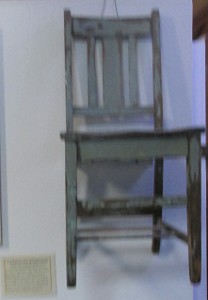 |
Further avenues of research are a number of persons associated with the restoration project identified by Rohan Westmore in 1994,
including a list of the participating pupils at Vincentia Public School.
The assistance and contributions by Rebekah Clements, Collections Assistant at the New Zealand Maritime Museum, and Andrea Hemmins, Photographic Archivist at the National Museum of the Royal New Zealand Navy, have been particularly valuable.
3. Detail the whaleboat's current condition and note any concerns.
The present condition of the JBMM’s Montagu Whaler could be said to be fair.
The Hull
The hull appears largely structurally sound, with the exception of three areas of concern.
There is a small crack in the hull, forward on the port side, and visible signs of stress under the stem and stern.
The latter was identified in October by David Payne and; on his suggestion; two blocks have been wedged into position to provide temporary support.
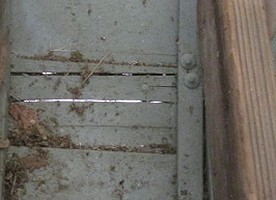 |
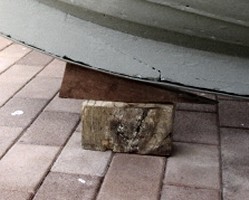 |
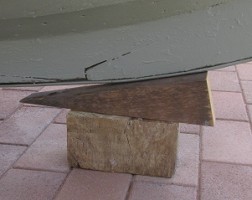 |
The paint work is on the exterior of the hull is in fair condition, but the interior is considerably better..
However, on most of the removable timber sections (that is, the grates, fore sheets, bottom boards, etc.) the varnish has cracked and visibly deteriorated.
These are need to be refurbished, a relatively simple process that would see the removal of the components to a suitable location for sanding and re-varnishing, projected for 2016-2017.
Similarly, the brass work requires cleaning with a suitable compound, particularly the dedication plate.
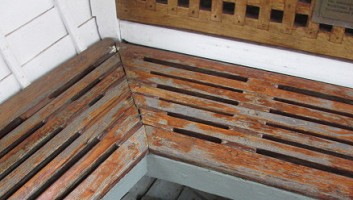 |
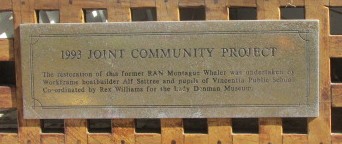 |
The condition of the vessel is not unexpected, given the vessel’s semi-enclosed location.
Although largely a dry area, the exhibit is subject to damage from the sun, wind, and extremes of temperature.
Critically, the question of security is of considerable concern, highlighted by the recent (noted 6th November) damage and theft when a brass cleat was removed from the rear thwart on the starboard side.
The replacement of the cleat could be difficult, if not expensive.
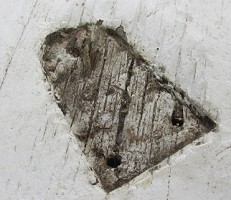 |
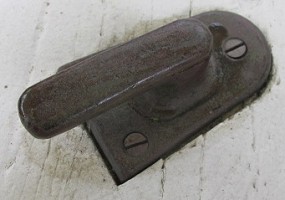 |
Of more concern is the possibility of damage by fire, either by natural causes or in a case of vandalism.
It is known that a Montague Whaler was destroyed at the LDMM by bushfire in 2001; to lose one whaleboat to fire may be regarded as a misfortune, to lose two looks like carelessness.
At the latest insurance assessment, the Montage Whaler was professionally valued at $? (dollar value available at the discretion of the Curator).
However, whatever this figure actually is, and admittedly without an intimate knowledge of the provisions of the current JBMM insurance policy, it is possible that the whaler’s present unsecured location may present some difficulties in any claim for damage or destruction.
Repainting the Hull
Following, or during, the proposed removal and restoration of the internal timber sections (projected for 2016-2017 and detailed above), attenttion focuses on the restoring the paint on the hull.
Without question, such major work needs to be examined fully before committing to its implementation.
At an extreme, depending on the extent of work required and a consideration of current WHS provisions in relation to facilitating access for the volunteers, there is a possibility that the vessel may have to be relocated, perhaps several times.
The Original Colours
The selection of the colour scheme is not in question.
On collection by the LDMM in 1991, both whalers had white hulls, were dark red below the water-line and with blue gunwales.
These colours were replicated by Alf Settree and the students of Vincentia Public School in their restoration of the whaler and in evidence when the boat was installed at the Museum in 1993.
There is no documentation in the JBMM’s files as to this unfortunate development, erasing of the work and intentions of the original restoration.
Furthermore, apart from the inappropriate choice of battleship-grey, the original and correct palette of blue-white-red is undoubtedly far more attractive and eye-catching.
Also note that the original restoration included looped life-lines along the gunwales, which are no longer present.
A detailed appraisal of the proposed re-painting of the whaler’s hull in the original colours, is to be prepared and documented in the JBWC Project for 2016-2017.
Lastly, the condition of the fittings supporting the ropes around the exhibit area are in poor condition.
Examination of possible alternatives will be canvassed by the JBWC in the new year and suggestions or solutions included in the JBWC Project for 2016-2017.
4. Following professional consultation and advice, clean the whaleboat and the superstructure.
After a consultation canvassing the general principles for cleaning a clinker boat with Shane Nunn, Shipwright, Sydney Heritage Fleet, at Pyrmont in September, the JBWC carried out the following work.
The mast was removed from the whaler and stored in the Ferry Well.
The whaleboat was cleaned inside and out in preparation for the Wooden Boat and Model Ship Festival in October.
The vessel was swept with a soft hand brush and then, using two buckets, each section was washed with a soft cleaning cloth using water with light detergent and then rinsed with water.
|
During October, the nuts on the bolts that lock the fore sheets were made free, in preparation for the removal of the fore sheets and bottom boards, scheduled for early 2016. This is necessary to access the bilge to remove the considerable dirt and leaf matter that has collected there, ideally employing a powerful vacuum cleaner. Also, consideration will be given to correctly cleaning the brass work, in particular the tarnished dedication plate in the stern. As previously noted, two blocks have been wedged under the stem and stern where there are visible signs of stress, as suggested by . David Payne in early October. For further comments see the condition report, above. |

|
This objective scheduled for introduction in early 2016.
6. Search the museum precincts to collect and collate any and all of the sails, rigging, gear and other materials associated with the whaleboat or the heritage small wooden boat fleet.
| All the sails, rigging and
oars have been located and displayed on the southern
wall of the Ferry Well. They are now housed in a suitable rack constructed from recycled components, sanded and painted by the JBWC. There are two main masts, one main sail, spars and rigging, and one mizzen sail, spars and rig. There is also a second rig, comprising of the spars to set a main and a mitzen sail, however the later is is broken, missing approximately 45cm from one end. Right: Mizzen sail, spars and rig. |
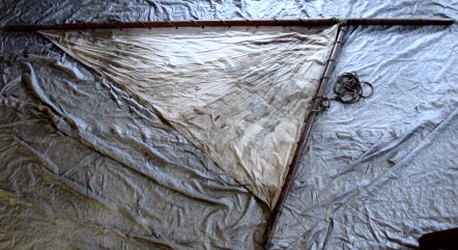 |
The second pair is in used condition, showing extensive wear, particularly to the blades which have been repaired with metal strips and nails.
7. Ensure that the details of the whaleboat and the respective gear are fully and correctly entered into the museum's digital catalogue.
This objective is currently on hold, awaiting further technical advice.
8. Scan, digitalise and update the whaleboat file held by CMC.
Scanning and digitalisation of the CMC Whaleboat files was completed in October 2015.
These are now available to the Curator on request.
9. Seek professional information and advice on the restoration and conservation of the whaleboat's sails and gear.
There is one set of sails comprising a main and a mizzen sail, but no jib.
There are two sets of masts, spars and rigging, with the sails fixed by ropes to one set of spars.
The Sails
The main sail is in very poor condition and the mizzen sail is not much better, although most of the ropes appear in good condition and closely conform to their positions as depicted in the literature.
Initial research has indicated that the subject of the restoration and conservation of sails is complex, confusing, and possibly very expensive.
Future avenues for further comments and advice include the ANMM and the SHF, and possibly staff at the Powerhouse Museum and the Australian Museum.
At this point, it is clear that the main and mizzen sail, and their spars and rigging should be continued to be kept in store, awaiting a more detailed and definitive analysis.
Masts, Spars and Rigging
All the masts, spars and rigging all appear to be in reasonable condition, apart from the second mizzen spar which has a broken end, missing about 45cm.
All the metal parts appear to be in evidence, but show signs of considerable wear.
However, in all cases, the varnish on the timber beams is cracking, worn and generally deteriorating.
The JBWC proposes that the second rig, be restored by a group of volunteers to working condition, a detailed appraisal to be provided in the JBWC Project for 2016.
Furthermore, it is proposed that that in conjunction with restoring the second rig, the possibility of establishing a group of volunteers to replicate a jib and the main and mizzen sails should be explored.
On the completion of these projects, the replica sails fitted on the restored masts and spars would produce a full working rig, that would be practical and a valuable addition in exhibiting this vessel.
The Oars
A similar approach is envisioned for the oars.
It is proposed that one pair be retained in their current condition and the second pair, ideally those in raw condition, should be restored to working condition to compliment the level of restoration of the whaler.
This would be carried out in conjunction with the proposed restoration of one set of masts and spars by the volunteer crew.
As a long-term objective (following the accumulation of practical skills and experience by the crew members following the restoration process of the whaler’s masts, spars and oars), the construction of a third pair of replica oars becomes a possibility.
Ideally, these should be another 15ft oar and the second, a 16ft sweep oar.
As above, a detailed appraisal of this proposal is to be provided in the JBWC Project for 2016.
10. Initiate research into the numerous and varied whaleboat histories that pertain to the JBMM's Montagu Whaler.
Constructed by Navy Shipwrights (872) or by Contractors (1107) ? ... and a mysterious Third Whaler.
The history of the JBMM's Montagu Whaler is a work in progress, complicated by its construction from two boats, numbers 872 and 1107. Further confusion arises with the provenance of a third whaler, said by Rohan Westmore to be supplied by Albatross Aviation Museum and stripped of its brass fittings to complete the restoration.
In addition, there is the question of the identity of a whaler known to be destroyed at the LDMM by a bushfire in 2001.
Apart from the brief report by Rohan Westmore, unfortunately, the identity of these ghost ships is not otherwise recorded in the JBMM files.
| Following a recent informal interview with Mr
John Settree, it currently appears that the JBMM’s
whaler is, essentially, 872; despite the stern of the
restored vessel bearing the number 1107 F. He noted that one of the whalers from HMAS Penguin was in very poor condition and it was apparently dismantled to provide additional parts in the restoration by Alf Settree and the students of the Vincentia Public School. In a report on the condition of both whalers by the Senior Technical Instructor Shipwright from HMAS Nirimba, examined before they were collected by the LDMM, indicates the poor condition of Whaler 1107, it would need a new backbone and at least 30 timbers ... renewed full length. Alternatively, the shipwright expertly details the condition of the other boat, and suggests that Whaler 872 would be a better proposition (for restoration). Therefore, it is highly probable that the JBMM’s whaler is predominantly the hull of number 872. |
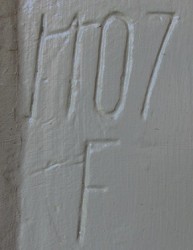 |
However, it appears that, by implication, 872 was built by navy shipwrights about 1944, Nirimba’s Shipwright confidently stating that it is 42 years old (in 1988).
In 1994, Rohan Westmore suggested a similar date of construction, reporting that the boat was built in Fremantle in 1945.
Given the the ship’s emblem afixed at the stem, it s probable that at least one of the whalers served aboard HMAS Queenborough, but this requires further research.
An International, and a Multi-functional, Vessel
Importantly, the history of the vessel’s design and its extensive use by the navies of Empire-Commonwealth nations is rich and fascinating, and with the staff at two museums in New Zealand already making a significant contribution.
While its reputation as a pulling and sailing work-boat is ensured, the Montagu Whaler also played an important role as a training vessel and it was sailed competitively and for pleasure.
Relevant documents, images and commentary are being complied digitally, some of these files are available to the Curator on request, and some others are now available online.
2015_12_25_JBWC_Project_1_ Report_A
B. Small Wooden Boat Fleet
1. Consult with the JBMM Curator to ensure the highest conservation practices are maintained.
The Curator is in regularly updated on all the work of the JBWC, as is the Exhibitions Coordinator and recently appointed manager, Ms. Diana Lorenz.
2. Prepare a brief condition report on the vessels of the JBMM heritage small wooden boat fleet.
Pedro
| The Pedro
is one of only two sailing boats in
the JBMM heritage fleet, the other
being the Montague Whaler. A remarkably attractive vessel, she was constructed in 1960 in Queensland maple and Shoalhaven cedar, restored in 1984 and donated to the Lady Denman Heritage Complex in 1994. Unfortunately, the actual design or class of the Pedro is yet to be identified. The general condition of the boat is excellent, although there is some major scuffing along the port gunwale. Of major concern is the centreboard, which has had a 12'' (30 cm) section sawn off one end, which is fortunately still present. The rigging is in disarray, some of the shackles are missing, they have been replaced with synthetic twine and the rig needs considerable modification and/or adjustment. There are no sails. The new dolly built by the JBWC in August is substantially more robust than the previous frame and, importantly, it has be constructed so that the rudder can now be properly affixed. The re-rigging of the Pedro and alternatives and difficulties in professionally restoring the centreboard to its original condition are to be explored by the JBWC in 2016. Right: Pedro dolly Number 1. |
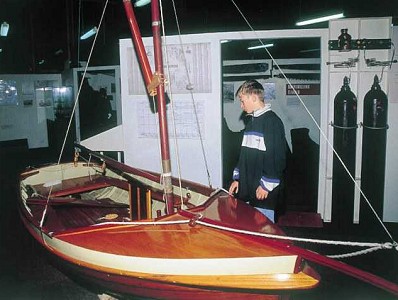  |
| The
museum has four
examples of clinker,
or lap-strake
construction, the Warren
being the smallest. This construction technique, dating from the Viking long ships of the first century AD, is also used in Montague Whaler and the Era Beach Surf-boat. The boat is solid and in very good condition, and its presentation has been greatly improved with the construction of its new dolly by the JBWC in September. While the dolly still needs to be painted black, iIt is now possible to exhibit the craft with its restored and working Seagull outboard motor correctly mounted on the stern. The addition of the row-locks, oars, anchor and a petrol can considerably enhance the exhibit. |
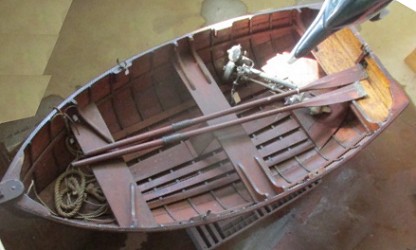 |
Almost generic in design and construction, the plywood canoe was used extensively around the world as a pleasure craft up to the 1970s, before being replaced by fibreglass and plastics.
This example of a plywood canoe is in good condition, as is its two-bladed paddle.
However the brass (?) screws that fix the plywood hull panels are prone to deterioration, producing a green powdery deposit at the screw-head.
Although these deposits were easily removed when the canoe was cleaned and prepared for the Wooden Boat and Model Ship Fair in October, they will certainly reappear over time.
The is some variation discernible in the quality of the finish of the varnish, initial feedback suggesting that it was possibly (inexpertly) re-vanished prior to its donation.
Thus, the screw-heads have not been properly sealed and they are susceptible to oxidisation.
The stand for the canoe was refurbished in September by the JBWC, with the addition of wheels to construct a dolly.
This dolly is yet to be painted, in black, to conform with the dollies of the other boats in the SWBF.
Surf-Ski
The surf-ski was invented by Port Macquarie fisherman, Harry McLaren in the 1920s and the design now commonly used at beaches around the world.
This huge double ski was built in Sydney, but used locally for fishing trips to Bowen Island.
The hull is in reasonable condition, but the varnish on the deck has badly deteriorated and it easily accumulates dust.
There are four leather foot-straps, a metal bung, and a metal fitting at the stern, probably to house a (missing) small rudder, worked by cables by the rear crewman.
Unfortunately, there are no paddles; these are usually with off-set double blades.
In its current location in the Ferry Well, the condition of the varnish can only further degrade.
As these craft were regularly reconditioned at the beginning of each summer, a sympathetic light sanding and re-varnishing of the JBMM surf-ski is definitely over-due.
This would also substantially improve the presentation of the vessel as a quality exhibition piece.
Furthermore, given its extreme length but very light weight, consideration could then be given to displaying the refurbished ski, at a suitable location in the museum, suspended by cables.
Lady Denman is inappropriate.
Firstly, its location on the ferry effectively sublimates the boat's significant status.
Secondary, its apparent role as the Lady Denman's tender is questionable.
Over many years of service, the ship's boat was probably a number of different craft, with an aluminium dingy in use by 1962.
While the surf-boat could be said to approximate the tender of circa 1956, all the known tenders had a transom, that is a square stern.
Also, given they were required for emergency use, the tenders were never fitted with a cover.
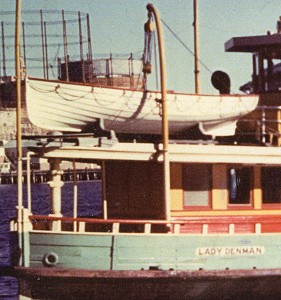 |
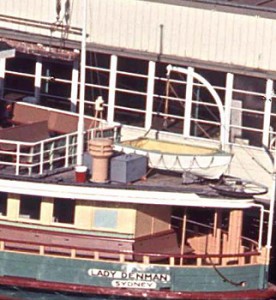 |
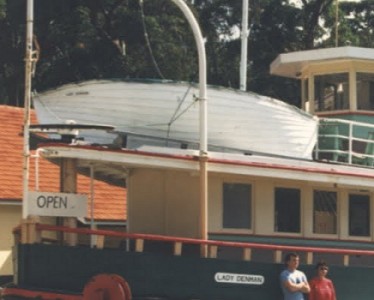 |
| When
installed on the ferry
around 2002, even in
respect of the tender of
1956, the surf-the boat was
clearly too large. This difficulty was overcome by having the keel slightly intrude into the upper-deck passenger area and then bolted to the adjacent post. At some point, the Era Beach surf-boat should be removed the deck of the Lady Denman and be replaced by a tender of appropriate design and construction. Clearly, this is likely to be a considerable effort, requiring a large team of volunteers and the skills and experience of professional shipwrights and engineers. However, this is not without precedent in the story of the Lady Denman-Jervis Bay Maritime Museum. |
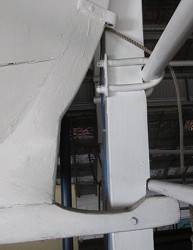 |
This boat is on the Australian Historic Vessels Register.
By definition, the aluminium Sea-Bee is strictly not part of the JBMM's Small Wooden Boat Fleet.
However, some observations can be made.
| The
condition of the vessel is poor,
particularly the timber deck. Now totally lacking any of the original varnish, similar to the surf-ski, it is likely to further deteriorate. Apparently, at some point, an attempt was made to (inexpertly) restore the hull, and the paint work is variegated and haphazard. The steering cables are in some disarray and the controls for the outboard motor have separated from the gunwale, and need remounting. Currently stored on tables and supported by bolsters, the boat requires a suitable dolly. Alternatively, its relative light weight could enable it to be exhibited in a similar manner to the surf-ski, as discussed above. |
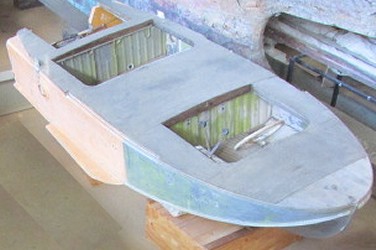 |
3. Confer and consult with the JBMM Exhibition staff to enhance the presentation and appreciation of the fleet for museum visitors.
In conjunction with Diana Lorenz, the JBWC prepared the Montagu Whaler to facilitate inspection and and similarly relocated the vessels of the SWBF for the Wooden Boat and Model Ship Fair in October.
The JBWC also assisted in the presentation of museum's collection of model ships, including the recently refurbished diorama of the Lady Denman under construction.
Apart from the Montague Whaler, all the SWBF vessels were on exhibition during November-December 2015 in the Vera Hatton Gallery.
4. In particular, rebuild or modify the dollies of the sail boat Pedro and the dingy, Warren.
The Pedro dolly was constructed by the JBWC during August and the dolly for the Warren completed in September, however it is still to be painted.
In addition, a dolly was constructed for the plywood canoe.
5. Establish formal contact with the the Australian Heritage Fleet, the ANMM and the Vaughan Evans Library to facilitate research and for professional advice and expertise.
The JBWC met with Shane Nunn, Sydney Heritage Fleet Shipwright, at Pyrmont in September for an informal but wide ranging discussion about messing around with boats.
David Payne of the ANMM and the AHVR has already offered significant support and information in respect of the SWBF.
Fortunately the catalogue of the Vaughan Evans Library is online via Trove, and inter-library loans are expertly arranged by Marie Torbruegge at the Shoalhaven City Library, Berry Street, Nowra.
In addition, following the visit of David Payne to the JBMM in October, contact has been made with Jenny Chapman and Chris Curry at the Berry Museum.
Included in their substantial collection is a flood-boat, one of two built by David Berry in 1860.
The second is held by the Shoalhaven City Council at their Ulladulla Depot and it is said to be installed in the new Swimming Centre being nearing completion at Nowra.
David is preparing documentation to have both vessels entered on the AHVR in 2016.
Remarkably, the Berry boat still has its horse-drawn cart, with solid block timber wheels.
VaughanEvans Library
H. T. Lenton and J. J. Colledge: Warships of World War II
London : Ian Allan, 1962-1968.
8 volumes. (72; 81; 96; 81; 71; 81; 72; 80 p.) : ill. ; 19 cm.
Part 6:Trawlers, Drifters and Whalers.
623.8252 LEN (000641-643,645-9)
Pullen, Rex: Survival at sea : in the whaler after the sinking of HMAS Armidale in 1942 : a personal account.
Glenorchy, Tas. : The Author, 1998.
8 leaves ; 30 cm.
940.545994
Australian War Memorial. Research Centre.
F 940.545994 P982s
6. Work in association with museum volunteers and members in the exhibition and promotion of the JBMM heritage fleet.
Ongoing.
7. Actively recruit enthusiastic and committed volunteers with a range of skills and experience to the JBWC to contribute to the success of the project.
This objective is currently on hold, and has been re-scheduled for early 2016.
8. Explore the potential avenues to study the use of heritage small wooden boats in a contemporary environment.
This objective is currently on hold, and has been re-scheduled for early 2016.
9. Prepare an outline of priorities and objectives of the JBWC for Phases 2-5, 2016-2020.
In preparation, scheduled for publication in early 2016.
2015_12_25_JBWC_Project_1_ Report_B
A Note on Maintaining a Collection in a .
In Museum Land, the current mantra is to retain the object in the condition in which it is acquired.
While this may be feasible for professional institutions, it is a heavy burden for small regional museums.
John Settree
After building timber boats for the past 60 years, John Settree, closed the family business in May 2014.
The Settree family began building timber boats and ferries on the banks of Currambene Creek at Huskisson in 1828.
Some of the vessels were up to 180 feet long and were used on the coastal and inland trade.
When his grandfather ran the business there were up to 24 employees, with modern technology the number declined to four.
Provisional: Phase 2:
2015-2016.
A. The Monatgu Whaler
1. Establish the extent of the whaleboat's rig and attempt to faithfully reproduce it with restored or replicated components.
2. Plan and construct a suitable dolly for the whaleboat.
(Note that to effectively install the whaleboat's rig, it will be necessary to move it from under cover.)
3. Consult and obtain professional advice, expertise and training from the Australian Heritage Fleet, the ANMM and the Vaughan Evans to assist with any scheduled refurbishment or restoration work.
4. Research and document:
a. A Brief History of Whaleboats, Ship's Boats and Longboats to 1890.
b. Rear Admiral Victor Alexander Montagu (1841-1915)
c. The History of the Montagu Whaler 1890-1965.
d. Whaleboats on Jervis Bay since 1791.
e. Whaleboat Commands for Flotilla Drill.
5. Following a positive response to 1.A.1, prepare and successfully submit an application to have the whaleboat included on the Australian Heritage Vessels Register.
B. Small Wooden Boat Fleet
1. Following the JBMM heritage small wooden boat fleet condition report (1.B.2), prepare a schedule of priorities.
2. Consult and obtain professional advice, expertise and training from the Australian Heritage Fleet, the ANMM and the Vaughan Evans to assist with any identified and scheduled refurbishment or restoration work.
3. Confirm the JBWC priorities and objectives outline for Phases 2-5, 2016-2020.
4. Ensure that the details of the JBMM heritage small wooden boat fleet and the respective gear are fully and correctly entered into the museum's digital catalogue.
5. Scan, digitalise and update the whaleboat files held by CMC in respect of the small wooden boat fleet.
6. Access or acquire a temporary vessel suitable for the study the use of heritage small wooden boats in a contemporary environment.
Also see:
A. The Monatgu Whaler
1. Establish the extent of the whaleboat's rig and attempt to faithfully reproduce it with restored or replicated components.
2. Plan and construct a suitable dolly for the whaleboat.
(Note that to effectively install the whaleboat's rig, it will be necessary to move it from under cover.)
3. Consult and obtain professional advice, expertise and training from the Australian Heritage Fleet, the ANMM and the Vaughan Evans to assist with any scheduled refurbishment or restoration work.
4. Research and document:
a. A Brief History of Whaleboats, Ship's Boats and Longboats to 1890.
b. Rear Admiral Victor Alexander Montagu (1841-1915)
c. The History of the Montagu Whaler 1890-1965.
d. Whaleboats on Jervis Bay since 1791.
e. Whaleboat Commands for Flotilla Drill.
5. Following a positive response to 1.A.1, prepare and successfully submit an application to have the whaleboat included on the Australian Heritage Vessels Register.
B. Small Wooden Boat Fleet
1. Following the JBMM heritage small wooden boat fleet condition report (1.B.2), prepare a schedule of priorities.
2. Consult and obtain professional advice, expertise and training from the Australian Heritage Fleet, the ANMM and the Vaughan Evans to assist with any identified and scheduled refurbishment or restoration work.
3. Confirm the JBWC priorities and objectives outline for Phases 2-5, 2016-2020.
4. Ensure that the details of the JBMM heritage small wooden boat fleet and the respective gear are fully and correctly entered into the museum's digital catalogue.
5. Scan, digitalise and update the whaleboat files held by CMC in respect of the small wooden boat fleet.
6. Access or acquire a temporary vessel suitable for the study the use of heritage small wooden boats in a contemporary environment.
Also see:
| History: Whales, Men and Boats | Catalogue: JBMM Montagu Whaler #600 |
| Whaleboat : References, Appendix, Notes | JBWC : Information for Members |
Jervis
Bay Whaleboat Crew :
Small
Wooden Boat Fleet of the JBMM
Sculpture
dedicated to Alf Settree,
1914-1998.
Jervis Bay Maritime Museum, Huskisson. Sculptor: Denis Davis OAM |
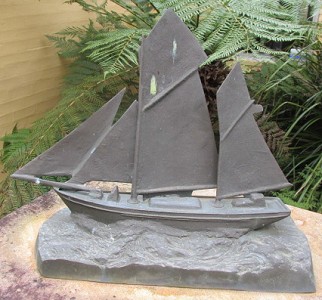 |
| home | catalogue | history | references | appendix |
